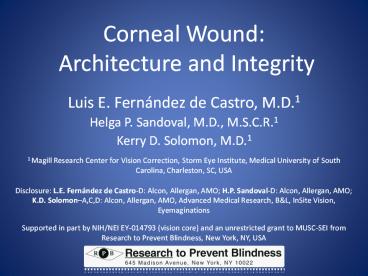Corneal Wound: Architecture and Integrity PowerPoint PPT Presentation
Title: Corneal Wound: Architecture and Integrity
1
Corneal Wound Architecture and Integrity
- Luis E. Fernández de Castro, M.D.1
- Helga P. Sandoval, M.D., M.S.C.R.1
- Kerry D. Solomon, M.D.1
1 Magill Research Center for Vision Correction,
Storm Eye Institute, Medical University of South
Carolina, Charleston, SC, USA
Disclosure L.E. Fernández de Castro-D Alcon,
Allergan, AMO H.P. Sandoval-D Alcon, Allergan,
AMO K.D. SolomonA,C,D Alcon, Allergan, AMO,
Advanced Medical Research, BL, InSite Vision,
Eyemaginations
Supported in part by NIH/NEI EY-014793 (vision
core) and an unrestricted grant to MUSC-SEI from
Research to Prevent Blindness, New York, NY, USA
2
Introduction
- Surgeons transitioning from larger to smaller
micro-incisions - Incision construction is key for preventing
hypotony, wound leaks, and ingress of
microorganisms (endophthalmitis)
3
Purpose
- To compare different incision sizes on clear
corneal incision (CCIs) and to determine which
incision width creates a square or nearly square
arquitecture
4
Materials and Methods
- A prospective study of 4 human cadaver eyes using
different incisions (4) were analyzed - Particular attention was given to ensure that the
wound had a square or near square configuration - Scanning electron microscopy was used to evaluate
wound architecture in each group
3.2 mm
2.8 mm
2.6 mm
2.2 mm
5
Materials and Methods
- After the CCIs
- Corneas were fixed in 2 Cacodylate
Glutaraldehyde - Processed and examined using SEM at the Medical
University of South Carolina, Charleston, SC - Imaging was performed using a magnification
factor of 50x, 100x, and 200x - Each specimen was examined and then photographed
according to a standard protocol - The outer and inner corneal wound surface were
evaluated
6
Results
- Qualitative observations
- On the epithelial side
- All incisions were adequately apposed
- Large incision width
- Rectangle configuration
- Small incision width
- Square configuration
7
3.2 mm Incision
Tear of Descemet membrane
Epithelial cell loss Apposed
Gapping
Outer
Inner
8
2.8 mm Incision
Epithelial cell loss Apposed
Gapping
Outer
Inner
9
2.6 mm Incision
Epithelial cell loss Gapping
Apposed Tear at the edge
Outer
Inner
10
2.2 mm Incision
Apposed
Gapping
Outer
Inner
11
Smaller incision widths permit a nearly squared
or squared configuration
Larger incision widths prevent a square
configuration
12
Conclusion
- Larger incision widths often preclude a square
construction due to infringement on the visual
axis - Smaller incision width permit a nearly square or
square construction - Square incisions can be more stable than
rectangular - Reducing risk of hypotony
- Reducing risk of wound leakage
- Reducing ingress of microorganisms
- Irregular apposition and minimal gapping in
endothelial edges due to direct mechanical trauma - Clinically shown to improve over time
- Ongoing study to determine wound integrity

